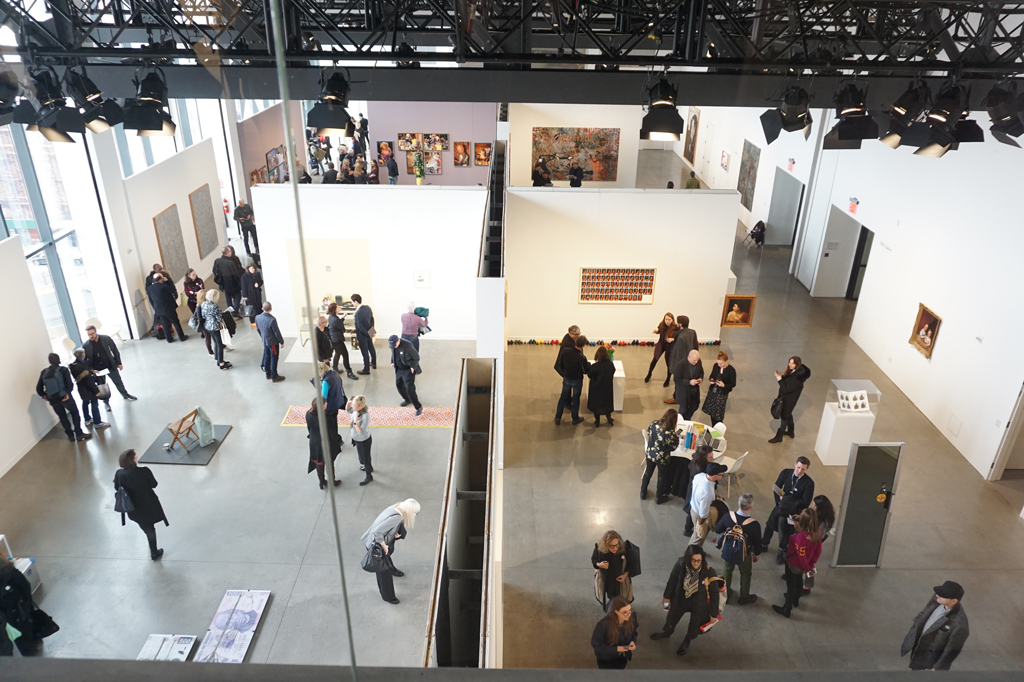[ad_1]
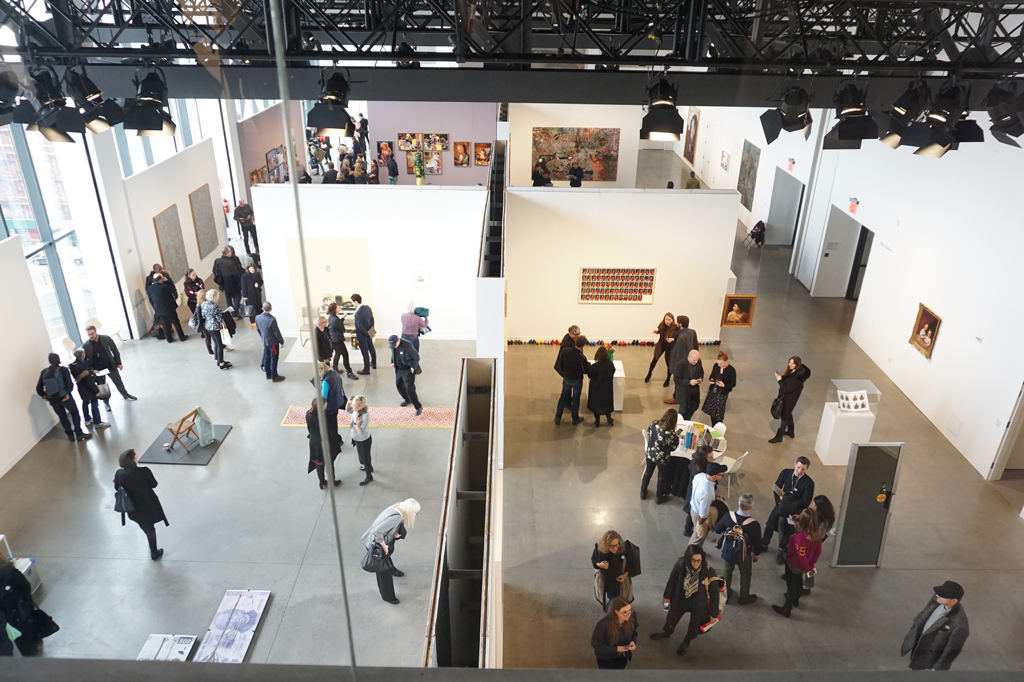
Overlooking the sixth floor of the 2018 edition of Independent New York.
MAXIMILÍANO DURÓN/ARTNEWS
It sometimes feels like it was only yesterday that the Independent art fair made its debut appearance at the old Dia building in West Chelsea in New York, as a more modestly scaled and tightly edited alternative to the city’s other fairs. So it was more than a little surprising today to chance upon wall text at the opening of the fair at Tribeca’s Spring Studios noting that a tenth edition is coming up next year. Elizabeth Dee, Darren Flook, Matthew Higgs, and Laura Mitterrand cooked up the idea in 2009, and the first show followed the next year. Where does the time go?
The first Independent had 40 exhibitors, while this year’s features 57 (still a very humane, manageable number to visit, even amidst a thrumming crowd), and 24 of them—a full 42 percent—are appearing in the fair for the first time.
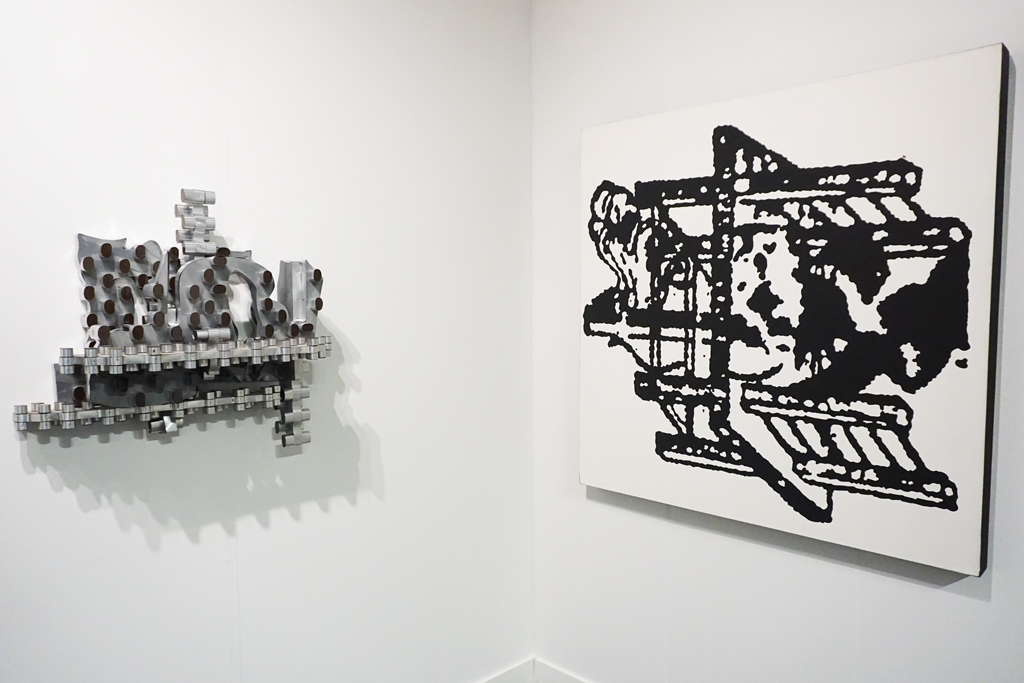
Works by, from left, Anne Libby and Peter Nagy, in the booth of New York’s Magenta Plains, at Independent New York 2018.
MAXIMILÍANO DURÓN/ARTNEWS
Among the newcomers is the Lower East Side outfit Magenta Plains, which is participating not only in its first Independent but also its first art fair ever. “We really felt like it was the most suited to the type of programming that we do,” Chris Dorland, one of the gallery’s founders, said. “The gallery is historical and intergenerational and very exhibition- and curated-heavy, and we felt that the Independent was without a doubt the best fair to respond to what we do.”
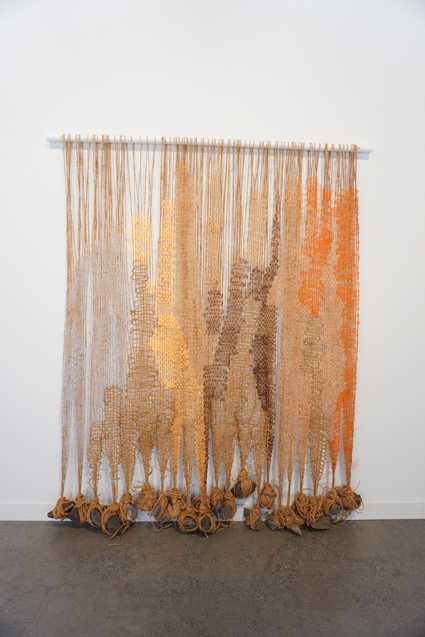
Work by Ann Cathrin November Høibo, in the booth of Standard (Oslo), at Independent New York 2018.
MAXIMILÍANO DURÓN/ARTNEWS
Dorland, who is also an artist, was manning a Magenta Plains booth that offers a cross-section of the gallery’s program, including quietly stunning monochrome paintings by Don Dudley, meaty, machinelike sculptural works by Anne Libby, and classic 1980s work by Peter Nagy (who is also an artist and the founder of New Delhi’s Nature Morte). Also on show: a number of small works on paper by Steven Parrino, whom Nagy was the first to show when he operated his gallery out of New York.
On the sixth floor—the fair is on the street-level and floors five, six, and seven—Standard (Oslo), another first-timer at Independent, has a gorgeously spare booth with work by three Scandinavian women—Nina Beier, Anna Zacharoff, and Ann Cathrin November Høibo, the last showing wall-hung works that consist of intricately woven coconut finger holding stones. The gallery’s Mary Grace Wright said that she enjoyed doing Independent when she worked for Bureau in New York and had encouraged Standard to do the fair. Earlier in the day, she said, Mette-Marit, the Crown Princess of Norway, had come by the booth to see the work of Høibo, who, like the Crown Princess, was born in Kristiansand.
It probably goes without saying that no prominent U.S. officials were at the Independent opening, but plenty of notable art types were: collectors Don and Mera Rubell, Nancy Portnoy, the Horts, and the Zabludowiczes; Basel honchos Noah Horowitz and Marc Spiegler; artists Maurizio Cattelan, Samara Golden, and Katherine Bernhardt; and curators Alex Gartenfeld, Katherine Brinson, Christopher Y. Lew, Norman L. Kleeblatt, and Piper Marshall.
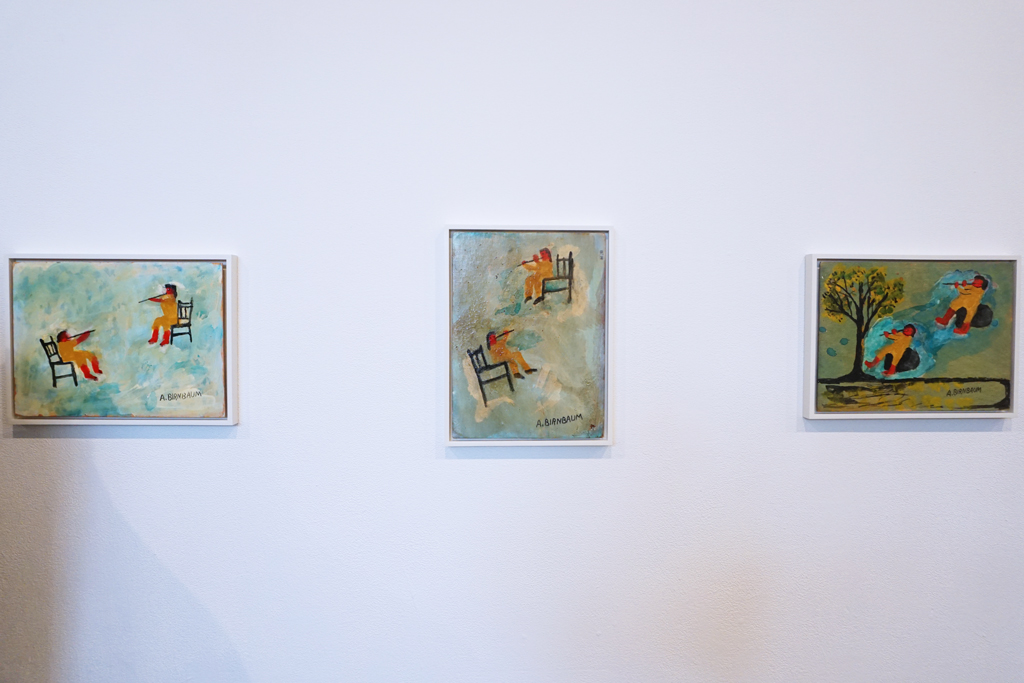
Works by Aaron Birnbaum in the booth of New York’s Kerry Schuss, at Independent New York 2018.
MAXIMILÍANO DURÓN/ARTNEWS
Painter Matt Connors was on hand, too, as the organizer of a stunning show at New York dealer Kerry Schuss’s booth of work by Aaron Birnbaum, who emigrated from Poland to the U.S. at age 10 and lived to be 103, having had a retrospective at the Aldrich Museum in Ridgefield, Connecticut, at age 102. He was one of the last “memory painters,” like Grandma Moses. He lived in Sheepshead Bay, Brooklyn, and had been a tailor. With such a legacy, the prices of his jewel-like paintings of figures, houses and rainbows in landscapes are shockingly modest: $8,000 to $35,000.
Such so-called “outsider,” or self-taught, artists are well-represented at Independent. There are some exquisite James Castles and vases by Eugene von Bruenchenhein (whose work will appear in the upcoming Front International triennial in Cleveland) at Fleisher Ollman, and New Yorker Andrew Edlin, who runs the Outsider Art Fair, is showing tiny works on paper—concentrated gems—by Melvin Way. (There’s also a Way show up at Edlin’s gallery, a short walk from the fair.)
At the center of his booth is a Terence Koh sculpture of an astronaut with a gold mask and a fabric suit covered by scores of buttons, including ones showing Chelsea Manning, Yoda, and the words “PEACE BEGINS WITH A SMILE.” Some of them Kohn had made, while others were purchased on eBay. The astronaut rests on a pyre of wooden sticks and assorted flora. “We picked up the wood and the flowers together,” Edlin said. “We went north of the city, a forest somewhere. Even yesterday he felt it needed a few more things, and he scooted outside and came back with some snowy branches. It’s been fun watching him go through his whole artistic process.”
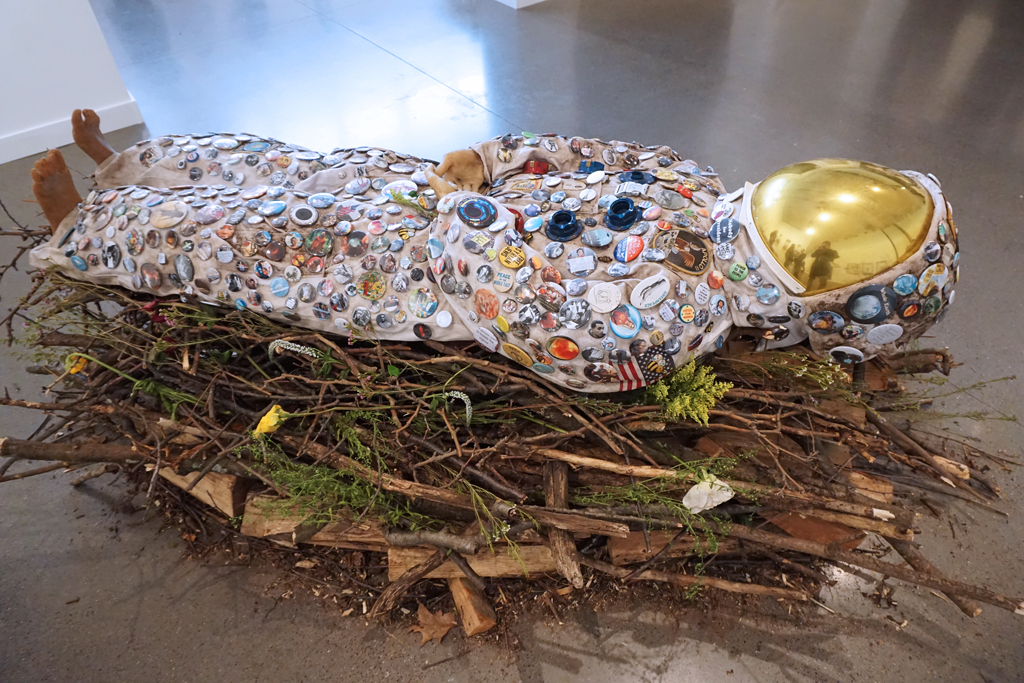
A Terence Koh sculpture in the booth of New York’s Andrew Edlin Gallery, at Independent New York 2018.
MAXIMILÍANO DURÓN/ARTNEWS
A row of drawings by the great Martín Ramírez is on offer at Ricco Maresca, which also had small, brooding drawings by the Austrian artist Leopold Strobl—priced just $2,000 to $3,200—that had hints of the controlled alienation of De Chirico, the color of Frank Walter, and the shapes of Ken Price’s graphic work.
Speaking of Price, Franklin Parrasch has a tableful of colorful ceramics that the late artist made toward the end of his career, between 2000 and 2008, priced from $110,000 to $550,000. These are the stippled, blob-like forms that look as though, when the lights turn off, they slither away and have lives of their own. Why did he bring them to Independent? “It all comes out of Price!” Parrasch said, making a sweeping gesture. Enough said.
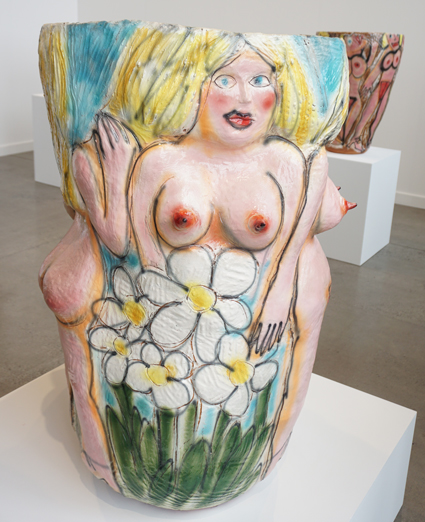
A sculpture by Ruby Neri in the booth of Los Angeles’s David Kordansky, at Independent New York 2018.
MAXIMILÍANO DURÓN/ARTNEWS
A few booths on, Los Angeles’s David Kordansky Gallery has more ceramics—bigger, brand new ones by Ruby Neri, the L.A.-based artist who started out in San Francisco doing graffiti-style work. Her ceramics feature female nudes with red-tipped breasts that poke out of the sculptures—urns that offer a feminist take on Bay Area funk (think Robert Arneson with two X chromosomes). Neri has recently made ceramics the focus of her practice, and these pieces could not have been better positioned—directly in front of a huge window—or shown on a better occasion, International Women’s Day. All but two of them had sold out in the first hour of the VIP preview for prices between $14,000 and $32,000. The biggest one—the centerpiece—went to a collector on the board of the Whitney Museum, and another one went to a previous president of the Guggenheim’s board. “She has moved on to a whole new level of collector,” Kordansky director Mike Homer said of Neri.
Over at Cheim & Read, early sculptural works from around 1980 to 1990 by Jack Pierson are on display. “We want to show the emotional depth of his work, from when he started making art,” the gallery’s Stephen Truax said. One resembles part of a charmingly economical hotel room, with a small desk, a chair, and a Supremes album sitting on a record player. “It recreates a room in Miami Beach that Jack drove to on Christmas break from Cooper Union in 1983,” Truax said. “So then only seven years later he’s memorializing his youth.” (Longtime art-world denizens may recognize a strip of carpeting that figured in Pierson’s first solo show, at Simon Watson in New York, in 1990.)
Other high-profile outings include Hans-Peter Feldmann at 303, Lizzie Fitch and Ryan Trecartin collaborating at Sprüth Magers, and the late Tony Feher at Sikkema Jenkins & Co. And one of the most-discussed pieces (also one of the most menacing) came courtesy of Christine Wang, who presented a painting at Night Gallery of Harvey Weinstein covered with the words, “I wish I was a white man.”

Ceramics by Cary Liebowitz in the booth of New York’s Invisible-Exports, at Independent New York 2018.
MAXIMILÍANO DURÓN/ARTNEWS
On the more whimsical end of the spectrum are small pieces by Cary Liebowitz, who has been cracking up the art world since the ’90s. They were flying off the walls (and table) at Invisible-Exports. The wall works, priced at $3,200 to $16,000, are latex on wood panel pie charts that represent proportions of things like “excessive self-confidence” (about 25 percent) and “low self-esteem” (about 75 percent). The pieces on the table are ceramics, priced at $1,500 to $7,500, and have messages like “impeachment proceedings.”
To gauge the mood of the day, we asked Risa Needleman of Invisible-Exports which piece she could have sold over and over. Her response: a pie chart with one half divided evenly between “I’m hungry” and “I hate you”—and the other half devoted wholly to “I hate me more.”
[ad_2]
Source link

